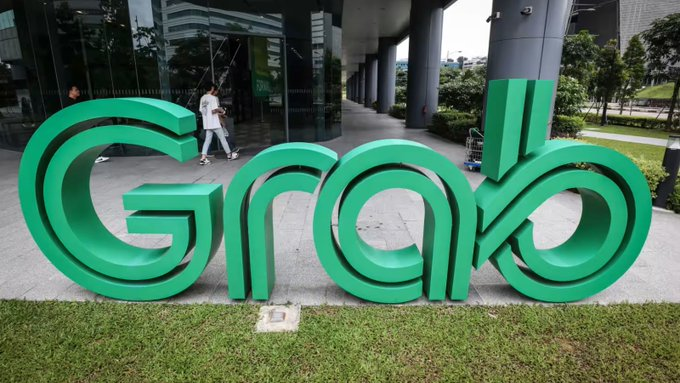Grab has entrenched itself as the backbone of Southeast Asia’s digital economy, fusing ride-hailing, food delivery, and financial services into a sprawling, integrated ecosystem. It didn’t just fend off $UBER — it absorbed its competition, consolidated market dominance, and reshaped its narrative from a cash-burning, high-growth gamble into a disciplined, self-sustaining enterprise. Today, with a market capitalization hovering around $20B and a war chest of $6B in liquidity, the company presents a valuation that, on paper, appears reasonable.
The financials underscore real progress. Revenue climbed 17% YoY, or 20% in constant currency. EBITDA has remained in the black for five consecutive quarters. And now, for the first time, Grab has crossed the threshold into GAAP profitability — a milestone that often signals a turning point for investor sentiment.
But does that translate into an explosive upside? Not exactly.
The emerging bullish thesis paints Grab as the next breakout stock, a dominant “super app” poised for exponential expansion. Yet, this narrative glosses over fundamental structural limitations. Grab is a well-run, deeply embedded regional player, not a disruptive, high-growth machine — and that distinction is critical when assessing its long-term return potential.
The optimism surrounding Grab hinges on the notion that scale and network effects will perpetuate a continuous expansion flywheel. The reality is far less boundless. Ride-hailing and food delivery, while indispensable, are finite markets with natural saturation points. As penetration levels stabilize across core geographies, the breakneck growth that defined the company’s early years inevitably slows.
Moreover, these industries are inherently capital-intensive and operationally demanding — a relentless cycle of subsidized incentives, logistical upkeep, and infrastructure investment. Even Uber, with its global scale and first-mover advantage, has struggled to transform mobility and delivery into lucrative, high-margin businesses. If Uber, operating in higher-income markets, hasn’t cracked the code, it’s naïve to assume Grab will defy economic gravity in a region with lower disposable income.
At its core, Grab isn’t an explosive disruptor poised for an outsized market re-rating. It’s a strategically sound, well-executed business within the constraints of its industry. Solid? Yes. A moonshot growth story? No. Investors chasing the next big breakout may want to recalibrate their expectations accordingly.
The company’s financial services segment, while growing rapidly, operates within a highly regulated environment that makes it more of an incremental business than a disruptive one. Loan volumes have surged 81% YoY, and deposits are up 50% QoQ, but these aren’t metrics that command premium valuation multiples. Grab is expanding access to financial services, not fundamentally changing how the industry operates. Unlike true fintech disruptors, which create entirely new financial infrastructure, Grab is still working within the existing banking framework — an advantage in some ways, but not the kind that leads to exponential valuation re-ratings. Additionally, the competitive landscape in digital banking is intensifying, with traditional banks and fintech startups aggressively entering the space, preventing Grab from establishing a monopoly in this segment.
Its geographic concentration further caps its growth potential. Grab is deeply entrenched in Southeast Asia, but its ability to scale beyond this region is limited by regulatory, economic, and infrastructure barriers. Many of the biggest stock winners of the last decade achieved their success by expanding into multiple large markets. Grab, in contrast, operates within a relatively fixed addressable market, without a clear pathway to replicate its dominance elsewhere. Unlike Uber, which maintains a global presence, or Meituan, which benefits from the scale of China’s domestic market, Grab lacks the international expansion potential that often fuels long-term stock appreciation.
Given these constraints, the current market enthusiasm seems overstated. At its core, Grab is a well-managed, regionally dominant business, but the expectation that it could 3x or 5x from here ignores the nature of its model. While the valuation isn’t unreasonable — its enterprise value sits at roughly $14B after accounting for cash — it’s also not deeply undervalued. Its core industries — mobility, food delivery, and financial services — all face inherent margin pressures, making structural profitability improvements a slow grind rather than a transformational leap. More importantly, there’s no obvious step-change growth catalyst.
The most transformative long-term winners don’t merely participate in markets — they redefine them. They birth entirely new industries, unlock vast, untapped revenue streams, or revolutionize monetization models to a degree that reshapes financial landscapes. Grab, however, does none of these at a scale that warrants the fervor some investors have assigned to it.
Yes, it’s a formidable regional player, boasting a strong competitive moat in Southeast Asia. Its operational efficiency is commendable. But structural advantages and competent execution alone do not create exponential returns. The companies that deliver outsized gains over a decade are those that fundamentally alter the game, not simply play it well.
Grab remains tethered to a business model that, while stable, lacks the explosive growth and margin expansion that separate market leaders from market disruptors. For investors seeking a steady, well-managed company with moderate upside, it’s a reasonable allocation. But for those hunting for asymmetric return potential — the kind that emerges from businesses with paradigm-shifting strategies — this isn’t where the gold lies. The next wave of market-defining companies will be architects of change, not just participants in existing ecosystems. Grab is a good business. But a breakout stock? It is not.
Source: Shay Boloor on X
FINE I’LL BUDGE — $GRAB IS OVERHYPED
— Shay Boloor (@StockSavvyShay) February 17, 2025
Grab has entrenched itself as the backbone of Southeast Asia’s digital economy, fusing ride-hailing, food delivery, and financial services into a sprawling, integrated ecosystem. It didn’t just fend off $UBER — it absorbed its competition,… pic.twitter.com/RQOsecN5Wv

Leave a Reply